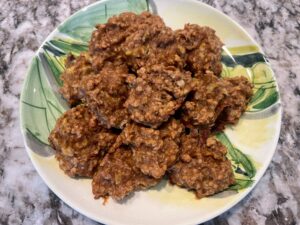Korean bean paste soup, known as Doenjang-Guk, is a classic comfort food loved for its rich, savory flavor and nourishing ingredients. It’s a simple dish made with fermented soybean paste, vegetables, and tofu, creating a healthy, hearty meal. This soup is not only satisfying but also quick and easy to make, making it perfect for busy days when you crave something warm and comforting.
The Story Behind Doenjang-Guk
Korean bean paste soup, or Doenjang-Guk, has a history rooted in traditional Korean cuisine that dates back centuries. The key ingredient, doenjang (fermented soybean paste), is believed to have been introduced during the Three Kingdoms period (4th-7th century).
Originally, doenjang was created as a way to preserve soybeans. Over time, its rich, savory flavor made it a beloved staple in Korean households. Through months of fermentation, the paste develops not only its deep, complex taste but also a range of health benefits.
Over the years, Doenjang-Guk has become a favorite comfort food. It’s loved for being simple, versatile, and nutritious. Today, it’s still an important part of Korean cuisine, showcasing the country’s history, culture, and focus on healthy eating.
Health Benefits of Bean Paste Soup
Korean bean paste soup, or Doenjang-Guk, is a nutrient-rich dish with many health benefits. It provides plant-based protein, essential vitamins, and minerals while supporting digestive health through probiotics. The antioxidants in doenjang help reduce inflammation and boost the immune system.
This soup is also heart-healthy, low in calories, and aids in natural detoxification. With its combination of vegetables, tofu, and fermented soybean paste, Doenjang Jjigae is a satisfying and wholesome addition to a balanced diet.
Hearty Korean Bean Paste Soup
In my Doenjang-Guk recipe, I use a combination of bok choy, zucchini, onions, and potatoes to create a well-balanced and hearty soup. The bok choy and zucchini add a refreshing touch, while the onions and potatoes bring a satisfying heartiness to the dish.
For those who enjoy spicier flavors, like my daughters, I incorporate a bit of Korean red pepper paste (gochujang) to give the soup an extra kick. If you’re open to non-vegan options, adding anchovies to the broth deepens the umami flavor beautifully.
You can make this soup ahead of time, and it pairs perfectly with hot steamed rice and a side of cabbage or radish kimchi.
Korean Bean Paste Soup Recipe

Serves 4 -5
Ingredients:
- 6 -7 cups water
- 4×4 inch piece of dried kelp (kombu)
- 1 cup Korean radish (mu), sliced
- 2 clove of garlic, minced
- 5 tablespoons fermented soybean paste (doenjang)
- 1/2 small onion, sliced
- 1 small-sized potato, cubed
- 1 zucchini, sliced
- 2 cups baby bok choy, chopped
- 1/2 – 1 tablespoons Korean red pepper paste (gochujang) (optional for spice)
- 2 cups firm tofu, cubed
- 2 dried broth anchovies (optional for non-vegan option)
- 1 cup oyster, button or seafood mushrooms, sliced
- Chopped green onions for garnish (optional)
Instructions:
1. Prepare the Broth
In a large pot, bring 6 cups of water to a gentle boil. Add the dried kelp, radish, minced garlic, and dried anchovies (if using) to enhance the broth’s depth of flavor. Let it simmer for 20-30 minutes, allowing the flavors to meld. After simmering, carefully remove and discard the kelp and anchovies while keeping the broth at a steady simmer.
2. Add Vegetables and Mushrooms
Stir in the fermented soybean paste (doenjang), ensuring it dissolves evenly. Then, add the sliced onions, cubed potatoes, zucchini, chopped bok choy, and mushrooms. Let everything simmer for 10-15 minutes until the vegetables reach your desired tenderness.
3. Add Spice (Optional)
If you prefer a spicier flavor, stir in Korean red pepper paste (gochujang). Mix well to evenly distribute the spice and enhance the overall flavor profile.
4. Add Tofu
Gently add the cubed tofu to the soup, top with freshly sliced green onions, and let it simmer covered over medium heat for 5–10 minutes, until the tofu is heated through.
5. Taste and Adjust
Taste the finished Korean bean paste soup and adjust the seasoning by adding more doenjang if needed to deepen the flavor.
Tips for Storing and Reheating

Leftovers can be stored in the fridge for 3 to 4 days. When reheating, you may notice the soup thickening or becoming saltier as it reduces. If this happens, simply add a bit of water to adjust the consistency and balance the flavor. In fact, leftover soup often tastes even richer as the flavors have more time to meld.
Doenjang-Guk does not freeze well due to the vegetables and tofu. Freezing can alter tofu’s texture, making it spongy or crumbly when thawed. For the best taste and texture, enjoy the soup fresh or within a few days of making it.
This Doenjang-Guk is a comforting classic, but if you’re in the mood for something spicier, check out my recipes for Kimchi Soup and Soondoobu (Soft Tofu Soup).














